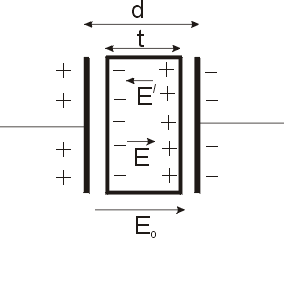What is a dielectric
A dielectric material is an insulator in which there are no free electrons.
This means that a dielectric will not be able to conduct current.
Dielectric constant
Dielectric constant K can be written as a ratio of  Permittivity of the medium
to
Permittivity of the medium
to  Permittivity of free space.
Permittivity of free space.

It can also be defined as the ratio of  the
capacitance with dielectric as the medium and
the
capacitance with dielectric as the medium and  is the capacitance with air or vacuum between the plates.
is the capacitance with air or vacuum between the plates.

Further it can also be defined as the ratio of  the
electric field between the plates with air or vacuum as the medium and
the
electric field between the plates with air or vacuum as the medium and  is the electric field between the plates with dielectric as the medium.
is the electric field between the plates with dielectric as the medium.

Polar and non-polar materials
Materials can be categeorized into polar or non-polar materials.
Polar materials
Materials and called polar materials when the molecules have a net dipole moment. This means that the center of mass of the positive charge and the center of mass of the negative charge in the molecule are slightly seperated
Non-polar materials
Materials and called non-polar materials when the molecules do not have a net diapole moment. This means that the center of mass of the positive charge and the center of mass of the negative charge in the molecule concide and are not able to create a dipole moment
Atoms due to their spehrical symmetry are always non-polar
Capacitor with dielectric

If we place a dielectric between the parellel plates of a capacitor and give a charge
to the capacitor then in the absence of a dielectric there is an electric field
 . Say the distance between the plates is d
and the thickness of the dielectric is t. Now, since positive charge is on one plate
and negative charge is on the other plate, it is going to induce diapole moment in the molecules
of the dielectric. If the molecules were initially non-polar they will have this induced however, if
they already had a diapole moment they will realign according to the positive and negative charge
on the plates, thus orienting themselves in the direction of the electric field. Now the left
side of the dielectric will have a net negative charge and ther right side a net positive charge. And,
as a result the direction of the induced electric field
. Say the distance between the plates is d
and the thickness of the dielectric is t. Now, since positive charge is on one plate
and negative charge is on the other plate, it is going to induce diapole moment in the molecules
of the dielectric. If the molecules were initially non-polar they will have this induced however, if
they already had a diapole moment they will realign according to the positive and negative charge
on the plates, thus orienting themselves in the direction of the electric field. Now the left
side of the dielectric will have a net negative charge and ther right side a net positive charge. And,
as a result the direction of the induced electric field  inside the dielctric will be from right to left.
inside the dielctric will be from right to left.
So since there is an electric field to the left due to induction, the net electric field
 inside the dielectric will reduce and it will be:
inside the dielectric will reduce and it will be:

However the direction of  will be the same as the direction of
will be the same as the direction of 
Effect of a dielectric on the capacitance of a capacitor
Let  be the area of each plate
be the area of each plate
In the absence of a dielectric the capacitance  can be written as:
can be written as:

Once the dielectric having a thickness  is placed between the plates the capacitance will change.
is placed between the plates the capacitance will change.
 the potential between the plates will be:
the potential between the plates will be:

Here in  is the product
of electric field
is the product
of electric field  and the distance
of space free of the dielectric, which is given by
and the distance
of space free of the dielectric, which is given by
 .
.
 is the product of the electric field
is the product of the electric field
 inside the dielectic and the thickness
inside the dielectic and the thickness  of the dielectric.
of the dielectric.
Now 
therefore 
we know that 
therefore 
or 
From Gauss’s Law we know that  where
where  is a the surface charge density, that is
the charge per unit area
is a the surface charge density, that is
the charge per unit area
so we can say that if  is the charge
on each plate, that is negative on one and positive on the other, then
is the charge
on each plate, that is negative on one and positive on the other, then

or 
we know that 
therefore 
hence 
we know that capacitance 
hence
This is the formula of capacitance with a dielectric which is not completely filling the plates
From here we can see that if the dielectric completely fills the plates then t will equal d. When we subsitute this then we get

we have seen that 
therefore 
Now as K is always greater than 1 that is  it emplies that
it emplies that 
Or if we put a dielectric between the plates of a capacitor then its capacitance is going to increase
Dielectric strength
It is the maximum value of electric field that a dielectric will be able to tolerate without electric breakdown.